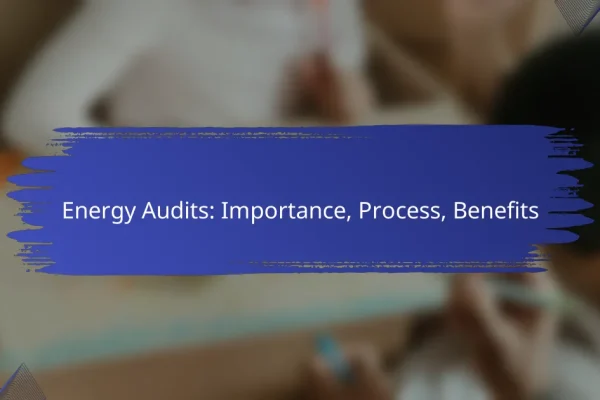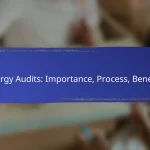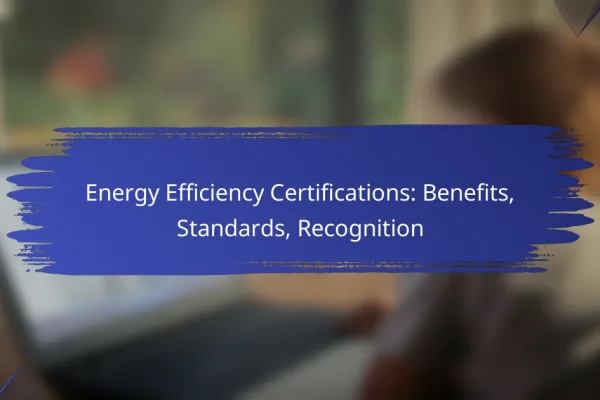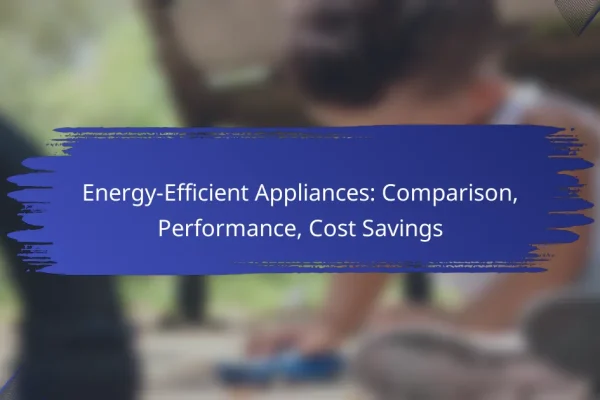What are the best energy efficiency solutions for businesses in the US?
The best energy efficiency solutions for businesses in the US include LED lighting upgrades, smart HVAC systems, energy management software, insulation improvements, and solar panel installations. These solutions can significantly reduce energy consumption and operational costs while promoting sustainability.
LED lighting upgrades
Upgrading to LED lighting is one of the simplest and most effective energy efficiency solutions. LEDs use up to 75% less energy than traditional incandescent bulbs and have a much longer lifespan, often exceeding 25,000 hours. This means lower electricity bills and reduced maintenance costs.
When considering an upgrade, evaluate the initial investment against long-term savings. Many utility companies offer rebates for LED installations, which can help offset costs. Ensure proper installation to maximize efficiency and light quality.
Smart HVAC systems
Smart HVAC systems optimize heating and cooling based on occupancy and environmental conditions, leading to significant energy savings. These systems can adjust temperatures automatically, reducing energy use during off-peak hours or when spaces are unoccupied.
Investing in a smart HVAC system may involve higher upfront costs, but the return on investment can be substantial through reduced energy bills. Regular maintenance is crucial to ensure these systems operate efficiently over time.
Energy management software
Energy management software provides businesses with insights into their energy consumption patterns, enabling better decision-making. By analyzing data, companies can identify inefficiencies and implement targeted strategies to reduce energy use.
Choosing the right software involves considering features like real-time monitoring, reporting capabilities, and integration with existing systems. Many solutions are available on a subscription basis, making them accessible for businesses of all sizes.
Insulation improvements
Improving insulation in buildings can significantly reduce heating and cooling costs by minimizing energy loss. Proper insulation helps maintain a consistent indoor temperature, reducing the workload on HVAC systems.
When upgrading insulation, focus on areas like attics, walls, and basements. Evaluate the R-value, which measures insulation effectiveness, and consider using materials that meet or exceed local building codes for optimal performance.
Solar panel installations
Installing solar panels allows businesses to generate their own electricity, reducing reliance on grid power and lowering energy costs. With federal and state incentives, the initial investment can be offset, making solar a viable option for many companies.
Before installation, assess your location’s solar potential and consider factors like roof orientation and shading. A professional assessment can help determine the best system size and configuration to maximize energy production and savings.
How can businesses reduce energy costs?
Businesses can reduce energy costs by implementing strategies that enhance energy efficiency and optimize energy usage. Key methods include conducting energy audits, using energy-efficient appliances, and participating in demand response programs.
Conduct energy audits
Energy audits are assessments that identify how much energy a business consumes and where it can improve efficiency. By analyzing energy usage patterns, businesses can pinpoint areas for cost savings and prioritize upgrades.
Consider hiring a professional auditor or using online tools to evaluate your energy consumption. Common findings include inefficient lighting, outdated HVAC systems, and excessive standby power usage.
Implement energy-efficient appliances
Switching to energy-efficient appliances can significantly lower energy costs. Look for appliances with the ENERGY STAR label, which indicates they meet strict efficiency guidelines set by the U.S. Environmental Protection Agency.
Examples include LED lighting, high-efficiency refrigerators, and smart thermostats. While the initial investment may be higher, the long-term savings on energy bills often justify the expense.
Utilize demand response programs
Demand response programs allow businesses to reduce or shift their energy usage during peak demand periods in exchange for financial incentives. Participating in these programs can lead to lower energy costs and contribute to grid stability.
To get started, check with your local utility provider for available programs and eligibility requirements. Businesses can save on energy bills by adjusting their usage patterns, such as reducing air conditioning during peak hours.
What are the benefits of energy efficiency for companies?
Energy efficiency offers companies significant advantages, including cost savings, improved public perception, and adherence to regulations. By optimizing energy use, businesses can reduce expenses and enhance their sustainability profile.
Lower operational costs
Implementing energy-efficient practices can lead to substantial reductions in operational costs. Companies often see savings of 10-30% on their energy bills by upgrading to energy-efficient lighting, HVAC systems, and appliances.
To maximize savings, businesses should conduct energy audits to identify areas for improvement. Simple measures, such as installing programmable thermostats or utilizing energy-efficient office equipment, can yield quick returns on investment.
Enhanced corporate reputation
Adopting energy-efficient practices can significantly boost a company’s reputation among consumers and stakeholders. Businesses that prioritize sustainability often attract environmentally conscious customers, leading to increased loyalty and sales.
Publicizing energy efficiency initiatives through marketing campaigns or sustainability reports can further enhance a company’s image. Engaging in community projects focused on energy conservation can also strengthen public relations and brand perception.
Compliance with regulations
Many regions have established regulations that mandate energy efficiency improvements for businesses. Compliance with these regulations not only avoids potential fines but can also qualify companies for government incentives or rebates.
Staying informed about local and national energy standards is crucial. Companies should regularly review their energy practices to ensure they meet evolving regulations, such as those set by the Environmental Protection Agency (EPA) or local energy authorities.
What criteria should businesses consider when choosing energy efficiency solutions?
Businesses should consider factors such as initial investment, long-term savings, scalability, and potential impacts on employee productivity when selecting energy efficiency solutions. These criteria help ensure that the chosen solutions align with both financial goals and operational needs.
Initial investment vs. long-term savings
The initial investment in energy efficiency solutions can vary significantly, from low-cost upgrades like LED lighting to larger expenditures for advanced HVAC systems. While upfront costs may be high, businesses should evaluate the long-term savings on energy bills, which can often offset these costs within a few years.
For instance, a company investing in energy-efficient appliances may see a return on investment (ROI) within three to five years, depending on usage and local energy prices. It’s crucial to conduct a cost-benefit analysis to understand the payback period and overall financial impact.
Scalability of solutions
When assessing energy efficiency solutions, scalability is essential for accommodating future growth. Solutions should be adaptable to changing business needs, whether that means expanding operations or integrating new technologies.
For example, modular energy management systems allow businesses to start small and gradually add features as needed. This flexibility can help avoid unnecessary costs and ensure that investments remain relevant as the business evolves.
Impact on employee productivity
Energy efficiency solutions can significantly influence employee productivity by creating a more comfortable and healthier work environment. Improved lighting, better air quality, and temperature control can enhance focus and reduce absenteeism.
Research indicates that workplaces with optimized energy use often report higher employee satisfaction and performance levels. Businesses should consider how energy efficiency measures can contribute to a positive workplace culture while also achieving sustainability goals.
What are the local incentives for energy efficiency in California?
California offers various incentives for energy efficiency, including rebates, tax credits, and financing options. These programs aim to encourage businesses and homeowners to invest in energy-saving technologies and practices.
Rebates for Energy-Efficient Appliances
California provides rebates for purchasing energy-efficient appliances, such as refrigerators, washing machines, and HVAC systems. These rebates can significantly reduce the upfront costs, often covering a portion of the purchase price, making it more affordable for consumers to upgrade.
To qualify, appliances typically need to meet specific energy efficiency standards set by the state. Checking the California Energy Commission’s website can help identify eligible products and the corresponding rebate amounts.
Tax Credits for Energy Improvements
Tax credits are available for businesses and homeowners who make energy-efficient upgrades to their properties. These credits can reduce the amount of state income tax owed, providing a financial incentive to invest in improvements like insulation, windows, and solar energy systems.
It is essential to consult with a tax professional to understand eligibility requirements and the application process for these credits, as they can vary based on the type of improvement made.
Financing Options for Energy Efficiency Projects
California offers financing programs to help cover the costs of energy efficiency projects. Programs like the Property Assessed Clean Energy (PACE) financing allow property owners to borrow money for energy upgrades and repay it through their property taxes.
These financing options often come with favorable terms, such as low-interest rates and extended repayment periods, making it easier for businesses and homeowners to undertake significant energy efficiency improvements without a large upfront investment.











